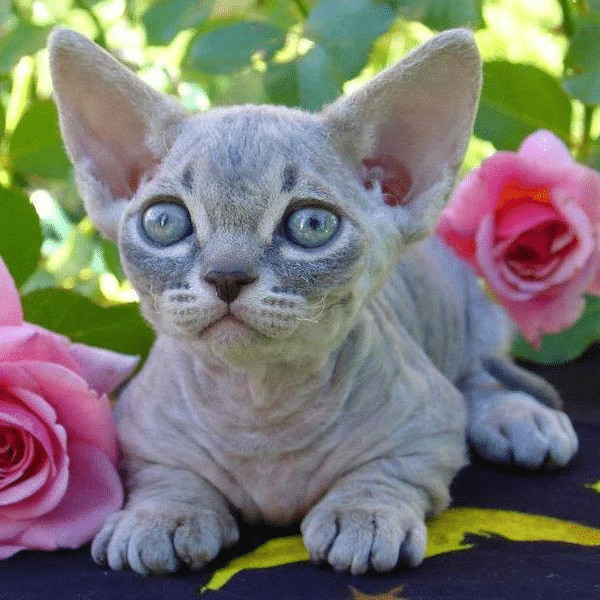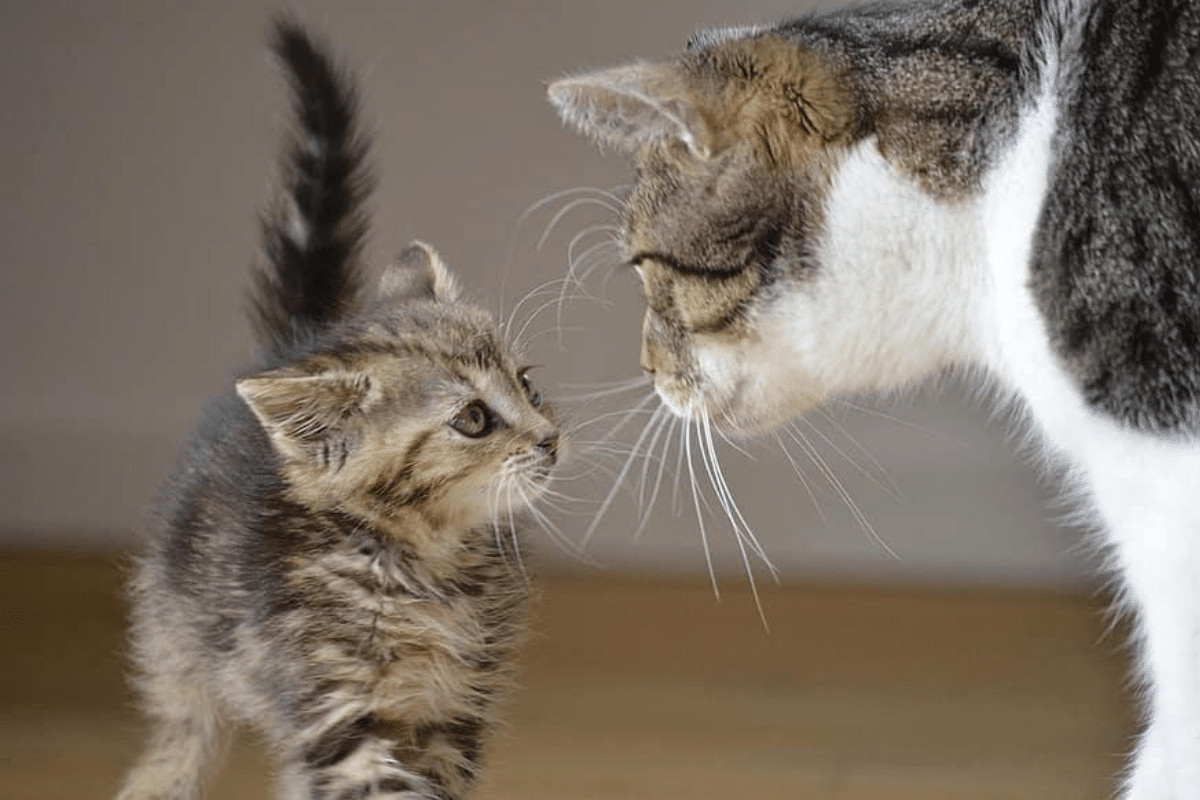As cute as your kitten is when it arrives, you know there is going to come a day that it’s no longer a tiny ball of fuzzy adorableness. But at what stage is a kitten considered an adult and when do cats stop growing? We are answering this question, as well as few others related to the growth stages of our fabulous felines. Before we start, though, it is important to understand the life cycle of a cat. Let’s take a quick look.
The Life Cycle of a Cat

While some breeds mature more quickly than others, in general, the life cycle of a cat can be broken down into 5 stages. These are as follows:
- 0-6 months – Between the ages of 0 to 6 months old, your cat is in its kitten phase. This is the earliest, and possibly cutest stage in its life cycle. It’s also the time your pet experiences the most growth and development in a relatively short space of time.
- 6 months to 2 years – Also known as the junior stage, your cat still hasn’t reached full maturity and is still growing. Spending quality time with your cat during this phase will go a long way in helping your cat feel confident in new situations.
- 3 to 6 years – This is the prime adult phase. And it’s when your cat is at its healthiest and most active.
- 7 to 10 years – Between the ages of 7 and 10, your cat is in what’s called the mature adult stage. And just as we become less active, so too do mature adult cats. This is also the time when they will gain weight and develop a few health issues, such as diabetes or kidney disease.
- 11 to 14 years – Cats at this age are in their senior phase. More time will be spent sleeping, and there’ll be little to no exercise. Around this time, your cat’s health begins to deteriorate.
At What Age Do Cats Stop Growing?
While the question itself is pretty straightforward, the answer to when does a kitten stop growing isn’t as simple. Although cats can reach adulthood at 12 months, they are still not considered fully developed. It’s only around the 18 months to 2-year mark when they reach their full size.
However, some of the larger breeds only stop growing between 4 and 5 years. Let’s take a look at 5 of the largest breeds in the world. In no particular order, they are as follows:
- Bengals
- British SHorthairs
- Ragdolls
- Savannahs
- Maine Coons
Bengal Cats

Described as a ‘small leopard’, a Bengal cat can grow up to 16 inches long and weigh between 16 and 22 pounds. Males, as you would expect, are typically bigger than female Bengal cats.
Of the larger breeds, Bengal cats reach their full size between 1 and 2 years.
At a glance, Bengals are:
- 13 to 16 inches long
- approximately 11 inches high
- 10 to 22 pounds in weight
- Full-grown within 1 to 2 years
British Shorthair Cats

British Shorthair cats can take anywhere between 3 and 5 years to be full grown. But according to proud pawrents of this beautiful breed, it is definitely worth the wait. On average, a British Shorthair will weigh between 7 and 18 pounds, with an approximate height of 20 inches.
At a glance, British Shorthair cats are:
- between 16 and 22 inches long
- between 14 and 20 inches high
- approximately 7 to 18 pounds in weight
- Full-grown between 3 and 5 years
Ragdoll Cats

Aptly named the Ragdoll, this breed of cat kind of flops in your arms while you are holding it. While it isn’t the biggest cat around, it does take 4 years to reach its full size. Females can grow up to 9 inches high, while males can typically reach 11 inches high and weigh between 8 and 20 pounds.
At a glance, Ragdoll cats are:
- 15 to 26 inches long
- 9 to 11 inches long
- 8 to 20 pounds in weight
- Full-grown at 4 years
Savannah Cats

The Savannah cat, also known as the ‘small cheetah’ is a mixed, or hybrid breed. They are crossed with the African Serval, and a domestic cat, and how they’re bred will play a role in how long it takes for them to stop growing. It is a little more confusing to work out the average size of the Savannah as they’re classed from F1 to F7.
This classification system refers to the number of generations from the Serval. Of all the classes, F1 is the biggest, weighing between 13 and 25 pounds and reaching a height of 14 to 22 inches. Savannah cats stop growing between 2 and 3 years.
At a glance, Savannah cats are:
- 20 to 25 inches long
- 10 to 19 inches high
- 12 to 20 pounds in weight
- Fully-grown between 2 and 3 years
Maine Coon Cats

It is fair to say Maine Coon cats are the largest of all the domestic breeds. Stewie, a Maine Coon holds the world record for being the longest cat, measuring in at a rather impressive 48.5 inches long. Very few other breeds reach this size. As kittens, they aren’t any bigger than their counterparts; however, the difference in size certainly becomes noticeable as they continue to grow, and grow… and grow.
At a glance, Maine Coons are:
- 48 inches long
- 8 to 16 inches high
- 25 pounds in weight
- Full-grown between 4 and 5 years
At the other end of the scale, there are smaller breeds that stop growing a lot sooner. Breeds such as Rexes, American Curls, Singapuras, and our personal favourite the Minskin, which stops growing at around 18 months.

Factors That Affect a Cat’s Growth
Although most cats take between 18 months and 2 years to reach their adult size, other factors can affect their growth. These include:
- Diet – The kitten phase is the time cats develop the fastest, which is why it is so essential to make sure they’re getting the nutrition they need. Kittens that aren’t getting the essential minerals and nutrients they need to grow will have stunted growth and reach their full size prematurely.
- Abandonment – kittens or young cats that have been abandoned are usually much smaller than they should be. This has a lot to do with their diet and a lack of nutrition. To help feral or stray kittens survive on minimum food and water, their bodies will shut down, and their growth will be stunted.
- Spaying or neutering – According to recent findings, when you have your cat spayed or neutered will have an effect on its size. If you spay or neuter your cat while it’s in its kitten phase, it will grow bigger, in length and height. However, older cats that undergo this procedure typically grow to the specific breed’s natural size.
- Bone defects or deformities – Some cats’ growth can also be affected by bone defects or deformities, such as dwarfism. While some of these are caused by genetics, diet also plays quite an important role.
When Are Cats Full Grown?
If you are looking for a definitive answer as to when do cats stop growing, we would have to say it is when they are between 10 months and 2 years old. However, as we have mentioned there are external factors that can affect this. And certain breeds take longer before they are fully grown.
As long as you are providing your kitten with a well-balanced, nutritional diet, plenty of exercise and love, it will reach its full size eventually. Our advice is to enjoy every stage of your cat’s life cycle, from kitten to senior, because in a blink of an eye, it will all be over.
As always, we love your feedback. Let us know if you found this article helpful in the comment section below, or better still, share it with a feline-loving friend. And while you’re at it, don’t forget to like us on Facebook.
And if you are interested in picking up some more fabulous feline facts have a browse through our cat library here.

















Thank your for your extensive answer and especially about things that may affect a cat’s growth. I’ve checked quite a few sites that basically said they are full grown at one year. We got a cat from the humane society just over a month ago they said is four years old, but she has grown since we got her. She had been abandoned and was at the humane society for nearly a year.